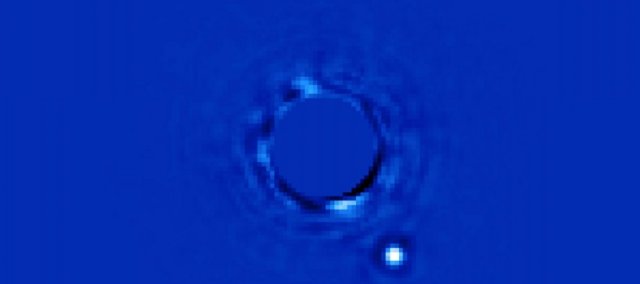
Most of the exoplanets we've detected have been spotted during transits, when they pass between their host star and Earth. Almost all the others have been inferred based on the fact that they gravitationally tug at their host star as they orbit around it. Very few exoplanets have been imaged directly, but that may be about to change.
Earlier this week, scientists revealed the first images taken with a new instrument, the Gemini Planet Imager, which has been installed on the (you guessed it) Gemini South telescope located in the Chilean Andes. The new hardware is so efficient that a known exoplanet that once took over an hour and considerable post-processing to image was apparent in a one-minute exposure, with no processing needed.
The twin Gemini telescopes (Gemini North is in Hawaii to image the northern sky) are already some of the most advanced hardware on the planet, featuring adaptive optics that correct the gaze of an eight-meter mirror. But directly imaging a planet is a distinct challenge due to the relative brightness of the planet relative to the host star. In terms of our own Solar System, Jupiter would appear 109 times fainter than the Sun when imaged at a distance.

Successfully imaging an exoplanet requires two things: the right planet and some very specialized hardware. The planet part is simple. For many years after their formation, large gas giants (called super-Jupiters) radiate a lot of heat trapped by their initial gravitational collapse. So any relatively young star can be targeted for imaging, as a super-Jupiters that's sufficiently distant from the star can be imaged in the infrared, where its own emissions dwarfs the starlight that it reflects.
It’s harder to modify an instrument to get it to actually see the exoplanets. To begin with, you have to have hardware, called a coronagraph, that blocks out the light of the central star. Some of this light will naturally diffract around the coronagraph, but it's possible to design one that directs the diffraction outside the imaging hardware. That's the part of the hardware that comprises the Gemini Planet Hunter.
The rest involves the optimization of existing hardware. Adaptive optics work great for adjusting the shape of the mirror to compensate for atmospheric distortions. Unfortunately, there are limits to how much a mirror can bend and how finely these bends can be controlled. Under the right circumstances (or, really, the wrong circumstances), the adaptive optics can create a speckle that remains stationary during the imaging. That could potentially be misinterpreted as a planet.
The team behind the Gemini Planet Imager carefully examined everything that affects the optical path through their telescope. They were so thorough that they were actually able to detect the presence of a vibration caused by the cooling equipment that keeps the imaging hardware chilled. A redesign of that hardware to eliminate this vibration is now in progress; in the meantime, the researchers started imaging while running it at one-third power.To test things out, the authors turned to the exoplanet ß Pictoris b, which had been previously imaged by several different observatories. The results were impressive. "The planet was immediately visible in a single raw 60s exposure," the authors write. "For comparison, a lower signal-to-noise H-band detection using [Gemini] required 3,962s of exposure and extensive [post-image processing]."
The test observations were done back in December of last year. With the hardware checked out, the Gemini Planet Imager is set to begin a survey of 600 young stars in our neighborhood, starting this year. Based on initial performance, it should be able to image planets with Jupiter's mass and up, orbiting within three Astronomical Units from their host star. (An Astronomical Unit is the average distance from the Earth to the Sun.) That survey is scheduled to start this year, and estimates are that it will find anywhere from 20-50 new exoplanets.
PNAS, 2014. DOI: 10.1073/pnas.1304215111 (About DOIs).
Reader Comments (31)
View comments on forumLoading comments...